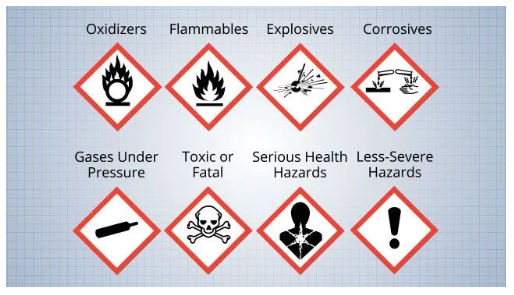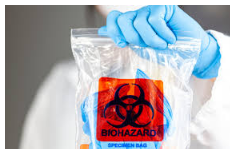Handling Hazardous Materials
Handling Hazardous Materials
Handling hazardous materials in a healthcare setting is crucial to ensure the safety of both healthcare workers and patients. This chapter focuses on the safe handling and disposal of biohazardous materials, highlighting the importance of understanding hazardous substances, following proper procedures, interpreting Material Safety Data Sheets (MSDS), and adhering to environmental safety regulations.
Safe Handling and Disposal of Biohazardous Materials
Identifying Hazardous Materials in Healthcare

1. Understanding Types of Hazardous Materials
Hazardous materials in healthcare include chemicals, biological agents, and radioactive substances. Each type poses specific risks and requires distinct handling protocols.
- Chemicals: These can be categorized into several groups, including corrosives (e.g., bleach, acids), flammables (e.g., alcohols, acetone), and reactive substances (e.g., certain cleaning agents). Chemicals used in the lab, such as reagents and solvents, also fall under this category.
- Infectious Waste: This includes any waste that may contain pathogens or is potentially infectious, such as blood-soaked materials, cultures from microbiology labs, and waste generated from patients with communicable diseases.
- Radioactive Waste: This type of waste comes from diagnostic and therapeutic procedures involving radioactive materials, such as in nuclear medicine.
2. Recognizing Labels and Symbols Indicating Hazardous Substances
The Globally Harmonized System (GHS) provides standardized labeling for hazardous materials. Labels include important information such as:
- Pictograms: Symbols that indicate specific hazards, such as toxicity, flammability, or corrosiveness.
- Signal Words: “Danger” for more severe hazards and “Warning” for less severe hazards.
- Hazard Statements: Descriptions of the nature of the hazard.
- Precautionary Statements: Guidance on how to minimize risks associated with the hazards.
Understanding these labels is essential for healthcare workers to recognize potential dangers and implement appropriate safety measures.
Procedures for Safe Handling and Disposal
a) Protocols for Safely Handling Sharps and Biohazardous Waste
Sharps Handling: Sharps (needles, scalpels, and broken glass) must be handled with extreme caution to prevent injuries.
- Always use safety-engineered devices when available.
- Never recap used needles unless absolutely necessary and using a one-handed technique.
- Immediately dispose of sharps in designated sharps containers to prevent needle-stick injuries.
Biohazardous Waste Handling:

- Use personal protective equipment (PPE) such as gloves and gowns when handling biohazardous materials.
- Minimize the generation of biohazardous waste through appropriate waste segregation at the point of generation.
b) Understanding Segregation of Waste Types
Proper waste segregation is critical to minimize the risk of exposure and contamination.
- Sharps Containers: These are puncture-resistant, leak-proof containers specifically designed for the disposal of sharp items. They should be clearly marked and located near areas where sharps are used.
- Biohazard Bags: Biohazardous waste should be disposed of in red or orange biohazard bags, which are labeled with the biohazard symbol.
- Regular Waste Bins: Non-hazardous waste, such as regular trash, must be disposed of separately and should not be mixed with biohazardous waste.
c) Methods for Proper Disposal According to Facility Policies and Regulations
Each healthcare facility must have specific protocols for waste disposal that comply with local, state, and federal regulations. These protocols may include:
- Incineration: For certain types of biohazardous waste, incineration may be required to ensure complete destruction of pathogens.
- Autoclaving: Sterilizing waste using high-pressure steam, which is effective for many types of medical waste.
- Landfill Disposal: Some types of non-hazardous waste can be disposed of in landfills, but only after ensuring they do not pose a risk.
Healthcare workers should be familiar with their facility’s disposal methods and ensure adherence to policies and procedures to mitigate risks.
Understanding Material Safety Data Sheets (MSDS)
1. Accessing and Interpreting MSDS for Chemicals Used in the Healthcare Setting
MSDS (now often referred to as Safety Data Sheets or SDS) provide comprehensive information about chemical products.
- Each MSDS includes sections detailing the chemical’s identity, hazards, handling and storage requirements, and emergency control measures.
- Access to MSDS should be readily available in healthcare settings, either in printed format or through electronic systems.
2. Training Staff on the Information Contained in MSDS, Including Hazards and First Aid Measures
Training programs should be established to ensure all staff members understand how to read and interpret MSDS.
Key training points include:
- Identifying hazardous ingredients and their risks.
- Understanding first aid measures in case of exposure (e.g., skin contact, inhalation).
- Implementing appropriate response protocols for spills or accidents.
Regular training updates should be provided to keep staff informed of any changes in regulations or new hazardous materials introduced into the facility.
Environmental Safety Regulations
1. Overview of OSHA Regulations Regarding Hazardous Materials
The Occupational Safety and Health Administration (OSHA) sets regulations to protect workers from hazardous conditions.
- OSHA’s Hazard Communication Standard requires that hazardous materials are properly labeled, and that employees are trained on chemical hazards.
- The Bloodborne Pathogens Standard outlines precautions for preventing exposure to blood and other potentially infectious materials.
2. Compliance with Local and National Regulations for Hazardous Waste Disposal
Healthcare facilities must comply with regulations from agencies such as the Environmental Protection Agency (EPA) and state health departments regarding hazardous waste management.
- This includes proper documentation of waste disposal methods, maintaining waste manifests, and ensuring that waste disposal contractors are licensed and compliant.
3. Training Staff on Reporting and Managing Spills or Exposures
Comprehensive training should be provided to ensure staff members know how to handle spills or exposures involving hazardous materials.
Training should cover:
- Immediate actions to take in the event of a spill (e.g., evacuation, containment).
- How to report incidents to the appropriate personnel.
- Procedures for decontaminating the area and materials affected by hazardous substances.
Having a clear emergency response plan and training staff on its implementation is vital for maintaining a safe healthcare environment.
Conclusion
In conclusion, handling hazardous materials safely in healthcare settings is paramount to protecting the health and safety of both staff and patients. By understanding the types of hazardous materials, recognizing labels, adhering to safe handling procedures, interpreting MSDS, and complying with environmental regulations, healthcare professionals can effectively manage risks associated with hazardous materials. Regular training and a commitment to safety protocols are essential for fostering a culture of safety and minimizing exposure to hazardous substances in the healthcare environment. This comprehensive approach to handling hazardous materials not only aligns with best practices but also enhances the overall quality of care delivered to patients.
By ensuring that staff are educated and equipped to handle hazardous materials properly, healthcare facilities can mitigate risks and promote a safe working environment, ultimately contributing to better patient outcomes and safety standards.
